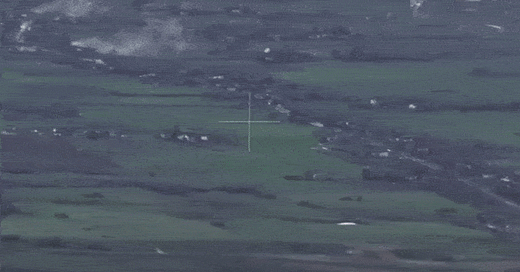Attacking Along a Main Road in Broad Daylight, a Large Russian Assault Group Broke a Lot of Rules—And Paid For It
A two-platoon assault is too big
A Russian assault group that attacked Ukrainian positions west of Andriivka in eastern Ukraine on or before Thursday broke a lot of rules.
It moved out in broad daylight and without the concealment offered by bad weather or smoke generators, advancing along a main road in a tightly packed column of at least a dozen armored vehicles carrying scores of infantry.
When the lead vehicle was hit and immobilized, the trailing vehicles piled up behind it. Their passengers bailed out and came under fire themselves—and soon the whole assault collapsed as Ukrainian artillery and drones knocked out vehicle after vehicle and hunted down the terrified dismounts.
Reportedly, the group lacked sufficient mine-clearing gear and thus its commander wouldn’t risk going off-road where mines might be harder to spot. That might be forgivable.
The commander’s other sins are less understandable. He sent out too many troops in too many vehicles against intact Ukrainian defenses.
In a recent report, the analysts at the Royal United Services Institute in London explained how successful Russian assault—“success” being a relative term given how many casualties Russian regiments suffer gaining any ground at all—usually goes.
Russian units, upon entering the [front] line, tend to conduct wide-ranging advances to contact in section strength, endeavoring to identify Ukrainian positions. First, they send sections/squads of poorly trained troops, perhaps eight personnel at a time (although some larger attacks consist of up to 30 personnel supported by one or two infantry fighting vehicles).
These are ordered to advance towards where they assess Ukrainian positions to be, conducting reconnaissance by drawing fire. If the group encounters resistance, Russian commanders assess where they believe the best lines of approach are, and in particular, where the boundaries between defensive units lie.
If Ukrainian positions are positively identified, sections are persistently sent forward to attack positions, which are further mapped and then targeted with artillery, [drones] and UMPK glide bombs. When rotation or disruption of the defense is achieved, Russian units aim to conduct more deliberate assault actions.
If the commander of the failed assault on Thursday was acting on accurate battlefield intelligence generated by armed reconnaissance, there’s no evidence of it. The assault column drew heavy and sustained Ukrainian fire, including precious cluster shells, clearly indicating there were no identified gaps in Ukrainian defenses for the assault group to exploit.
The humiliated commander, assuming he wasn’t with the column on Thursday and survived the day’s debacle, also ignored an important lesson other Russian commanders have learned about scale.
“Actions are rarely above section size, unless fog or peculiarities of the defense favor a larger attack, in which case, platoon actions are sometimes launched,” RUSI noted. But the Thursday assault involved at least two platoons of vehicles—potentially four or more sections.
The attacking column was big, loud, easy to locate by air—and, in concentrating so many valuable armored vehicles in such a small space over such a short time, a poor application of risk-mitigation. The Russian commander deployed, and lost, four sections when he should have deployed, and risked, just one.
Read more:
When a Ukrainian T-64 Blasts a Russian Vehicle at Point-Blank Range, It's Because the T-64 Had Unseen Help
More than three years into Russia’s wider war on Ukraine, the Russian armed forces still have more tanks than the Ukrainian armed forces have. This despite Russian forces losing 3,900 tanks to Ukrainian actions—roughly as many tanks as the Russians deployed on the eve of the wider war.






